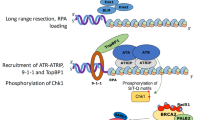Abstract
When two types of mammalian cells were treated with ethidium bromide for several hours, the mitotic figures showed no chromatid breaks or exchanges but a high incidence of sticky chromosomes. Electron microscopic examinations revealed that many chromosomes are connected by submicroscopic chromatin strands of various widths. Chromosome stickiness, therefore, is interpreted as entanglement of chromatin fibers between unrelated chromosomes, probably caused by abnormal condensation behaviors prior to mitosis. Presumably, chromatin breaks would occur when sticky chromosomes separate during anaphase. Such microscopically undetectable breaks expressed as various kinds of chromosomal aberrations in the next mitosis when the damaged cells were permitted to recover in the absence of ethidium bromide.
Similar content being viewed by others
References
Angerer, L. M., Moudrianahis, E. N.: Interaction of ethidium bromide with whole and selectively deproteinized deoxynucleoproteins from calf thymus. J. molec. Biol. 63, 505–521 (1973)
Beadle, G. W.: A gene for sticky chromosomes in Zea mays. Z. indukt. Abstamm.-U. Vererb.-L. 63, 195–217 (1932)
Brinkley, B. R., Stubblefield, E.: Ultrastructure and interaction of the kinetochore and centriole in mitosis and meiosis. In: Advanc. Cell Biol. 1, 119–185 (1970)
Crawford, L. V., Waring, M. J.: Supercoiling of polyoma virus DNA measured by its interaction with ethidium bromide. J. molec. Biol. 25, 23–30 (1967)
Hsu, L. Y. F., Hirschhorn, K., Goldstein, A., Barcinski, M. A.: Familial chromosomal mosaicism, genetic aspects. Ann. human Genet. 33, 343–349 (1970)
Hsu, T. C., Arrighi, F. E., Klevecz, R. R., Brinkley, B. R.: The nucleoli in mitotic divisions of mammalian cells in vitro. J. Cell Biol. 26, 539–553 (1965)
Hsu, T. C., Pathak, S., Shafer, D. A.: Induction of chromosome crossbanding by treating cells with chemical agents before fixation. Exp. Cell Res. 79, 484–487 (1973)
Lindegren, C. C.: The biological function of deoxyribonucleic acid. J. theor. Biol. 1, 107–119 (1961)
McGill, M., Hsu, T. C., Brinkley, B. R.: Electron-dense structures in mitochondria induced by short-term ethidium bromide treatment. J. Cell Biol. 59, 260–265 (1973)
Stubblefield, E.: Centriole replication in a mammalian cell. In: The proliferation and spread of neoplastic cells (Univ. of Texas M. D. Anderson Hospital and Tumor Inst. Symposium), p. 175–193. Baltimore: Williams and Wilkins 1967
Swanson, C. P., Johnston, A. H.: Radiation-induced pycnosis of chromosomes and its relation to oxygen tension. Amer. Naturalist 88, 425–430 (1954)
Unakul, W., Hsu, T. C.: Induction of chromosome banding in early stages of spermatogenesis by ethidium bromide. Chromosoma (Berl.) 44, 285–290 (1973)
Waring, M. J.: Complex formation between ethidium bromide and nucleic acids. J. molec. Biol. 13, 269–282 (1965
Author information
Authors and Affiliations
Rights and permissions
About this article
Cite this article
McGill, M., Pathak, S. & Hsu, T.C. Effects of ethidium bromide on mitosis and chromosomes: a possible material basis for chromosome stickiness. Chromosoma 47, 157–166 (1974). https://doi.org/10.1007/BF00331803
Received:
Issue Date:
DOI: https://doi.org/10.1007/BF00331803




